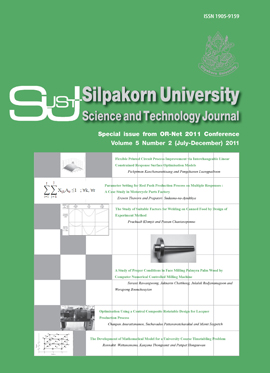The Development of Mathematical Model for a University Course Timetabling Problem
Main Article Content
Abstract
This research is to study the problem of classroom timetable generating due to an increase amount ofstudent. The generator of classroom timetable needs to arrange it properly according to the limited resources ,i.e., a number of classrooms, loading capacity of classroom, periods, and number of teachers. Importantly, thegenerating of this timetable construction has to be considered together-with the proportion between capacityof classroom and number of students; otherwise it will increase expense and extra-period requiring. Aninappropriate assignment between courses to classrooms will require more classroom utilization. The expensewill increase since fee is charged and forwarded to the faculty of Engineering for classroom utilization. Inaddition inappropriate assignment will also cause requiring extra periods between 3:45 and 6:25 PM. Thisoccurs often at present and leads to ineffective learning.Consequently, the generating of timetable needs to be concerned about expense and time. This researchis to study a course timetabling problem of Silpakorn University by building up mathematical model to findout an optimal solution. The main objectives are 1) the lowest expense generating; and 2) the least extraperiodspending. The programs used for the mathematical solution in this research are IBM ILOG CPLEX12.2. The result was found that solving the classroom timetable problem using a mathematical model couldreduce the costs of 8,115 baht / week and the extra-periods required could be reduced from 10 periods to 6periods.
Downloads
Article Details
References
Daskalaki, S., Birbas, T., and Housos, E. (2004). An integer programming formulation for a case study in university timetabling, European Journal of Operational Research, 153: 117-135.
Gunawan, A., Ng, K. M., and Poh, K. L. (2007). Solving the Teacher Assignment-Course Scheduling Problem by a Hybrid Algorithm, World Academy of Science, Engineering and Technology, 33: 259-264.
Nakasuwan, J., Srithip, P. and Komolavanij, S. (1999). Class Scheduling Optimization. Thammasat International Journal of Science and Technology, 4: 88-98.
Oladokun, V. O. and Badmus, S. O. (2008). An Integer Linear Programming Model of a University Course Timetabling Problem. The Pacific Journal of Science and Technology, 9: 426-431.
Ragsdale, C. T. (2004). Spreadsheet Modeling & Decision Analysis. A practical introduction to management science. Thomson Southwestern, Canada.
Taha, H. A. (2003). Operations Research: An Introduction, Prentice Hall, England.
Wasfy, A. and Aloul, F. (2007). Solving the University Class Scheduling Problem Using Advanced ILP Techniques, In IEEE GCC Conference, Bahrain, November 2007.


